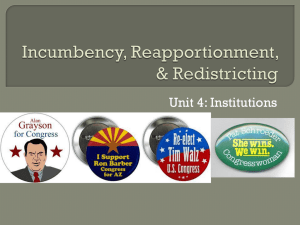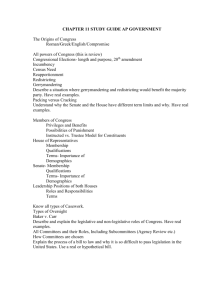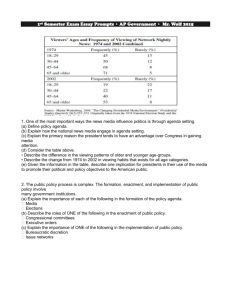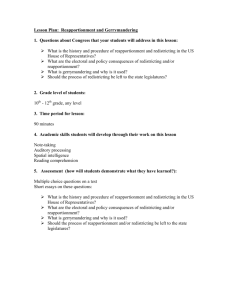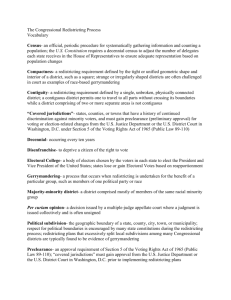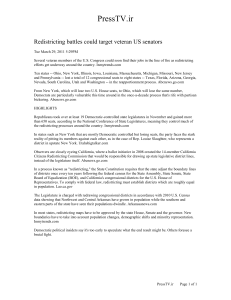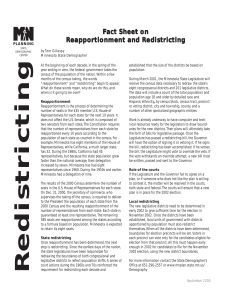Presentation - University of Nevada, Las Vegas
advertisement
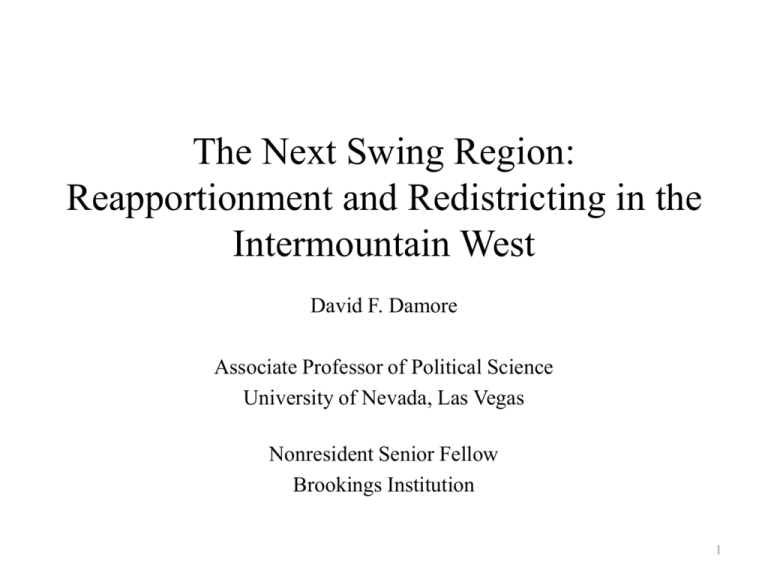
The Next Swing Region: Reapportionment and Redistricting in the Intermountain West David F. Damore Associate Professor of Political Science University of Nevada, Las Vegas Nonresident Senior Fellow Brookings Institution 1 Reapportionment and Redistricting in the Intermountain West I. Reapportionment and Redistricting Politics II. Regional Quirks III. 2001 Overview IV.A Decade of Transition V. 2011 Overview VI. Implications 2 Reapportionment and Redistricting in the Intermountain West I. Reapportionment and Redistricting Politics 3 Reapportionment and Redistricting Politics • Reapportionment – After the decennial census, House seats are reapportioned to account for population disparities. • In 2000, NC bested UT by fewer than 900 citizens for the 435th House seat. • Because the size of the House is capped, reapportionment is a zero sum game. – Disparate growth patterns within states often necessitate the reapportionment of state legislative seats. 4 2010 Reapportionment of House Seats _________________________________________________________________ State +/- New Total ___________________________________________________________________________ Arizona Florida Georgia Nevada South Carolina Texas Washington Utah Illinois Iowa Louisiana Massachusetts Michigan Missouri New Jersey New York Ohio Pennsylvania +1 +2 +1 +1 +1 +4 +1 +1 -1 -1 -1 -1 -1 -1 -1 -2 -2 -1 10 27 14 4 7 36 10 4 18 4 6 9 14 8 12 27 16 18 ______________________________________________________________________________ 5 Reapportionment and Redistricting Politics • Redistricting – Transforms raw population data and geographic spaces into political representation. – Prior to the 1960s states devised their own standards. • Gerrymandering. • Malapportionment. – In the 1950s, 12% of the population could elect a majority of the Nevada Senate. 6 Reapportionment and Redistricting Politics • The Reapportionment Revolution – Baker v. Carr (1962) and Wesberry v. Sanders (1964) established the “one person, one vote” standard that eradicated malapportionment. – States are obligated to regularly redraw boundaries. • New Mexico used the same plan from 1911 to 1949. – State courts take over if the political branches fail. 7 Reapportionment and Redistricting Politics • The Voting Rights Act – Section 2 permits, and in some instances requires, states to create majority-minority districts to protect against minority vote dilution. – Section 5 obligates that redistricting plans in some locales be precleared by the Department of Justice. • Arizona is the only preclearance state in the region. 8 Reapportionment and Redistricting Politics • Other Constraints – Compact, contiguous, and keeping communities of interest intact. – Partisan gerrymandering is constitutional. – Population deviations. • House: none. • State legislative districts: up to 10%. 9 Reapportionment and Redistricting Politics • Responsibility for Redistricting – Historically, under the purview of state legislatures. – Today, 21 states use commissions for all or part of their redistricting. • • • • In 13 states commissions have responsibility. In two states commissions advise legislators. In five states commissions serve as “backups.” The Iowa process. 10 Reapportionment and Redistricting in the Intermountain West I. Reapportionment and Redistricting Politics II. Regional Quirks 11 Redistricting Related Characteristics of the Intermountain West States ___________________________________________________________________________________________ State 2000-2010 Growth a Upper Lower Size of Professionalism Redistricting Term Chamber Chamber Legislature Ranking b Controlled by Limits Size Size Set by ___________________________________________________________________________________________ AZ 24.6% 30 60 Statute 10 Commission Yes CO 16.9% 35 65 Constitution 14 Commission/ Legislature c Yes ID 21.1% 35 70 Constitution 29 Commission No d NV 35.1% 21 42 Statute 30 Legislature Yes NM 13.2% 42 70 Constitution 39 Legislature No UT 23.8% 29 75 Constitution 46 Legislature No d ___________________________________________________________________________________________ a Data from the U.S. Census Bureau, Data from the Squire Index for 2003. c Maps for the Colorado Legislature are drawn by the Colorado Reapportionment Commission, while the Colorado Legislature draws the maps for the state’s seats in the U.S. House of Representatives. d Voter initiated and approved term limits in Idaho and Utah were repealed via legislative action. b 12 Reapportionment and Redistricting in the Intermountain West I. Reapportionment and Redistricting Politics II. Regional Quirks III. 2001 Overview 13 Summary of Redistricting Outcomes in the Intermountain West States, 2001 ___________________________________________________________________________________________ State Litigated Issues Outcome ___________________________________________________________________________________________ AZ Yes Initial preclearance denied and lack of competitiveness challenged (final resolution 5/04). Effective Republican gerrymander CO Yes Initial CRC Senate and U.S. House maps and 2003 U.S. House redistricting invalidated (final resolution 6/04). Lean Democratic ID Yes Excessive population variation for state legislative districts. Third plan accepted by Idaho Supreme Court Favorable to Republicans and rural interests NV No Partisan composition of CD3 and legislative expansion (resolved in special session). Bipartisan incumbent protection NM Yes Reversion plan set by state court for U.S. House map and some state legislative districts redrawn to insure electoral access for Native American communities. Lean Democratic The Census Bureau undercounted Utah’s population by not Republican gerrymander considering Mormon missionaries and used illegal statistical estimates for part of the 2000 count (both cases dismissed in federal court). ___________________________________________________________________________________________ UT Yes 14 2001 Overview • Commissions are no panaceas. • Redistricting guidelines across the region vary considerably. • Partisan gerrymanders are rare. 15 Reapportionment and Redistricting in the Intermountain West I. Reapportionment and Redistricting Politics II. Regional Quirks III. 2001 Overview IV.A Decade of Transition 16 Change in Population Diversity in the Intermountain West States, 2000-2010 __________________________________________________________________________________ Non-White Population State 2000 2010 Hispanic or Latino Population +/- 2000 2010 +/- __________________________________________________________________________________ AZ 36.2% 42.2% +6% 25.3% 29.6% +4.3% CO 26.5% 30% +3.5% 17.1% 20.7% +3.6% ID 12% 16% +4% 7.9% 11.2% +3.3% NV 34.8% 45.9% +10.1% 19.7% 26.5% +6.8% NM 55.3% 59.5% +4.2% 42.1% 46.3% +4.2% UT 14.7% 19.6% +4.9% 9% 13% +4% __________________________________________________________________________________ Data from the U.S. Census Bureau. 17 Change in Population Density in the Intermountain West States, 2000-2010 ___________________________________________________________________________________ State Metropolitan Census Statistical Area National 2000-2010 Rank Growth Population Share (2000) Population Share (2010) +/- ___________________________________________________________________________________ AZ Phoenix-Mesa-Glendale 14 28.94% 63.38% 65.59% +2.21% CO Denver-AuroraBrooomfield 21 16.71% 50.65% 50.57% -.08% ID Boise-Nampa 86 32.64% 35.92% 39.33% +3.41% NV Las Vegas-Paradise 30 41.38% 69.19% 72.25% +3.06% NM Albuquerque 57 24.41% 40.11% 44.08% +3.97% UT Salt Lake City 50 16.03% 43.38% 40.67% -2.70% ___________________________________________________________________________________ Data from the U.S. Census Bureau. 18 Democratic Party Strength in the Intermountain West States, 2000-2010 Data are Ceasar and Saldin’s measure of state party strength with higher values indicating greater Democratic electoral strength. Data for years 2000 through 2008 from http://scholar.harvard.edu/saldin/data. Data for 2010 calculated by author. 19 Impact of the 2010 Election in the Intermountain West States _________________________________________________________________________________________ State Governorship Upper Chamber Lower Chamber U.S. House U.S. Senate _________________________________________________________________________________________ AZ Republican Hold - 2 Democrats -5 Democrats -2 Democrats Republican Hold CO Democratic Hold -1 Democrat -5 Democrats -2 Democrats Democratic Hold ID Republican Hold No Change -5 Democrats -1 Democrat Republican Hold NV Republican Hold -1 Democrat -2 Democrats -1 Democrat Democratic Hold NM Republican Pick-up No Change -8 Democrats -1 Democrat No Race UT Republican Hold -1 Democrat -5 Democrats No Change Republican Hold _________________________________________________________________________________________ Data from National Conference of State Legislatures. 20 Partisan Control in the Intermountain West States, 2010 and 2011 ___________________________________________________________________________________ 2010 State Legislative Control Governor Party 2011 State Control Legislative Control Governor Party State Control ___________________________________________________________________________________ AZ Republican Republican a Republican Republican Republican Republican CO Democratic Democratic Democratic Divided Democratic Divided ID Republican Republican Republican Republican Republican Republican NV Democratic Republican Divided Democratic Republican Divided NM Democratic Democratic Democratic Democratic Republican Divided UT Republican Republican a Republican Republican Republican Republican ___________________________________________________________________________________ Data from the U.S. Census Bureau. a Governor took office via succession in 2009. 21 Reapportionment and Redistricting in the Intermountain West I. Reapportionment and Redistricting Politics II. Regional Quirks III. 2001 Overview IV.A Decade of Transition V. 2011 Overview 22 Summary of Redistricting Outcomes in the Intermountain West States, 2011 ___________________________________________________________________________________________ State Litigated Issues Likely Outcome ___________________________________________________________________________________________ AZ Yes Federal challenge to preclearance requirement and state challenge to AIRC open meeting and procurement laws. Effective Republican gerrymander CO Yes Reversion plan set by state court for House maps. Competitive and Latino friendly map adopted by CRC. Competitive ID Yes Inability to resolve constitutional and statutory space constraints prior to ICCR expiration (process to be completed by new commissioners). Favorable to Republicans and minimizing urban influence NV Yes Reversion plan set by state court and applicability of Section 2 of Voting Rights Act. Lean Democratic NM Not yet Reversion plan likely to be set by state court. Lean Democratic UT Not yet Division of communities of interest. Republican gerrymander ___________________________________________________________________________________________ 23 Reapportionment and Redistricting in the Intermountain West I. Reapportionment and Redistricting Politics II. Regional Quirks III. 2001 Overview IV.A Decade of Transition V. 2011 Overview VI. Implications 24 Implications • Two Schools of Thought – “The most political activity in America.” • Partisanship triumphs in the swing states. • The politics of space are at issue in the red states. • Term limits and political ambition. – Fomenting political renewal and uncertainty. • Future growth patterns. • The rise of the nonpartisans. 25 Implications • State Level Effects – The withering of rural influence. – Rising Latino clout. • A Mixed Bag Nationally – 29 House seats doesn’t cut it. – A green Senate delegation. – Four swings states? 26
